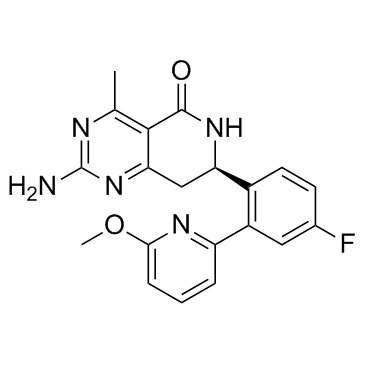934343-74-5
| Name | (7R)-2-amino-7-[4-fluoro-2-(6-methoxypyridin-2-yl)phenyl]-4-methyl-7,8-dihydro-6H-pyrido[4,3-d]pyrimidin-5-one |
|---|---|
| Synonyms |
NVP-HSP990(HSP990)/NVPHSP990(HSP-990)
(R)-2-Amino-7-(4-fluoro-2-(6-methoxypyridin-2-yl)phenyl)-4-methyl-7,8-dihydro-6H-pyrido(4,3-d)pyrimidin-5-one UNII-E0WBA7B62L NVP-HSP990 HSP-990 Pyrido[4,3-d]pyrimidin-5(6H)-one, 2-amino-7-[4-fluoro-2-(6-methoxy-2-pyridinyl)phenyl]-7,8-dihydro-4-methyl-, (7R)- NVP-HSP990,HSP990 (7R)-2-Amino-7-[4-fluoro-2-(6-methoxy-2-pyridinyl)phenyl]-4-methyl-7,8-dihydropyrido[4,3-d]pyrimidin-5(6H)-one |
| Description | NVP-HSP990 is a potent and selective Hsp90 inhibitor, with IC50 values of 0.6, 0.8, and 8.5 nM for Hsp90α, Hsp90β, and Grp94, respectively. |
|---|---|
| Related Catalog | |
| Target |
HSP90α:0.6 nM (IC50) HSP90β:0.8 nM (IC50) GRP94:8.5 nM (IC50) TRAP1 ATPase:320 nM (IC50) |
| In Vitro | NVP-HSP990 is a potent and selective Hsp90 inhibitor, with IC50 values of 0.6, 0.8, and 8.5 nM for Hsp90α, Hsp90β, and Grp94, respectively. NVP-HSP990 (10 μM) shows no affect the ATPase activity of topoisomerase II, a GHKL (Gyrase, Hsp90, Histidine Kinase, MutL) family ATPase, closely related to Hsp90. NVP-HSP990 also exerts efficient effects on c-Met, Hsp70, p-ERK and p-AKT in CTL-16 cells, with EC50s of 37 ± 4, 20 ± 2, 11 ± 1, and 6 ± 1 nM, respectively. NVP-HSP990 suppresses the proliferation of BT474, A549, H1975 and MV4;11 cells, with GI50s of 7 ± 2, 28 ± 5, 35 ± 4, and 4 ± 1 nM, respectively[1]. NVP-HSP990 inhibits cellular proliferation of GTL-16, with an EC50 of 14 nM[2]. NVP-HSP990 (5-500 nM) inhibits the multiple myeloma cell lines, with IC50s of 27-49 nM after treatment for 72 h. NVP-HSP990 induces apoptosis in multiple myeloma cell lines (0-100 nM), leads to cell cycle arrest in the G2/M phase (25-200 nM), and induces apoptosis via caspase-8 followed by caspase-3 activation (100 nM). NVP-HSP990 increases HSP70 expression and interacts with Akt and ERK signaling. Moreover, NVP-HSP990 (100 nM) in combination with melphalan, causes synergistic effects on growth inhibition in multiple myeloma cells and increases cleavage of caspase-3, caspase-8, and caspase-9 and activates caspase-2[3]. |
| In Vivo | NVP-HSP990 (2.5 to 5 mg/kg twice weekly, or 5 to 15 mg/kg weekly, p.o.) causes dose proportional antitumor efficacy, without obvious loss or overt signs of toxicity in a GTL-16 tumor bearing mice. NVP-HSP990 (5 or 10 mg/kg weekly, p.o.) also results in significant inhibition of tumor growth in BT-474 breast cancer model. NVP-HSP990 (5 mg/kg twice weekly or 15 mg/kg weekly, p.o.) inhibits the growth of tumor in the MV4;11 xenograft model. Furthermore, NVP-HSP990 (0.5 mg/kg every day, 14, 5 mg/kg twice weekly, or 15 mg/kg weekly, p.o.) displays antitumor efficacy in H1975 and A549 tumor models[1]. NVP-HSP990 (5, 15 mg/kg, p.o.) shows prolonged suppression of c-Met levels with 30% and 50% reduction and exhibits antitumor activities in GTL-16 tumor xenograft[2]. |
| Kinase Assay | His-tagged Hsp90α N-terminal domain protein (N-Hsp90α-His) is diluted to 2× the final concentration in the assay buffer consisting of 50 mM Hepes, pH 7, 6 mM MgCl2, 20 mM KCl and 0.1% BSA. The Hsp90 is dispensed into 96 well polypropylene plates at 50 µL per well. In a separate polypropylene plate, test compounds (NVP-HSP990) are diluted to 40× their final concentration in 100% DMSO. Serial dilutions in DMSO are made in 3-fold increments. 2.5 µL of diluted compounds are transferred to the 50 µL of Hsp90 and mixed. Background wells receive 25 µM (final concentration) radicicol. Biotin-radicicol is diluted into assay buffer at 2× the final concentration and 50 µL are added to the Hsp90/compound plate. DMSO is at a final concentration of 2.5%. Samples are incubated at room temperature for 2 hours before 50 µL are transferred to NeutrAvidin-coated plates. Plates are incubated 1 hour, washed 3× with DELFIA wash buffer (5 mM Tris, pH 7.5, 0.1% Tween 20, 0.1% sodium azide, 0.9% NaCl), and then 50 µL per well of 3 nM Eu-anti-His diluted into DELFIA assay buffer are added. The plates are next incubated 2 hours at room temperature, washed 4×, and then 50 µL enhancement solution are added. Plates are gently shaken for 7-10 minutes before reading in a VICTOR2 instrument[2]. |
| Cell Assay | GTL-16 Cells (1 × 103) are plated into 96 well tissue culture plates and cultured at 37°C, 5% CO2. Serially diluted compounds (NVP-HSP990) are added to the cells and are incubated for 72 hrs. at 37°C, 5% CO2. Cell proliferation is determined using Cell Viability assay[2]. |
| Animal Admin | Human tumor xenograft models GTL-16, NCI-H1975, BT474, and MV4;11 are implanted subcutaneously with 50% Matrigel in nude or severe combined immunodeficient mice. Mice are randomized into cohorts (10 mice/group for efficacy) when tumors reach 200 to 500 mm3. NVP-HSP990 is administered orally in a vehicle of 100% polyethylene glycol (PEG400). Tumor caliper measurements are converted into tumor volumes using the formula: [length × (width)2]/2. Relative tumor inhibition is calculated as %T/C = 100 × dT/dC, where, dT or dC = difference of mean tumor volume of drug treatment (T) or vehicle (C) on the final day of the study and the randomization volume. Statistical comparisons are conducted using a one-way ANOVA, followed by the Dunn or Tukey post hoc test. Differences are statistically significant at P < 0.05[1]. |
| References |
| Density | 1.3±0.1 g/cm3 |
|---|---|
| Molecular Formula | C20H18FN5O2 |
| Molecular Weight | 379.388 |
| Exact Mass | 379.144440 |
| PSA | 107.24000 |
| LogP | 1.44 |
| Index of Refraction | 1.627 |
| Storage condition | -20℃ |
| HS Code | 29339900 |
|---|
